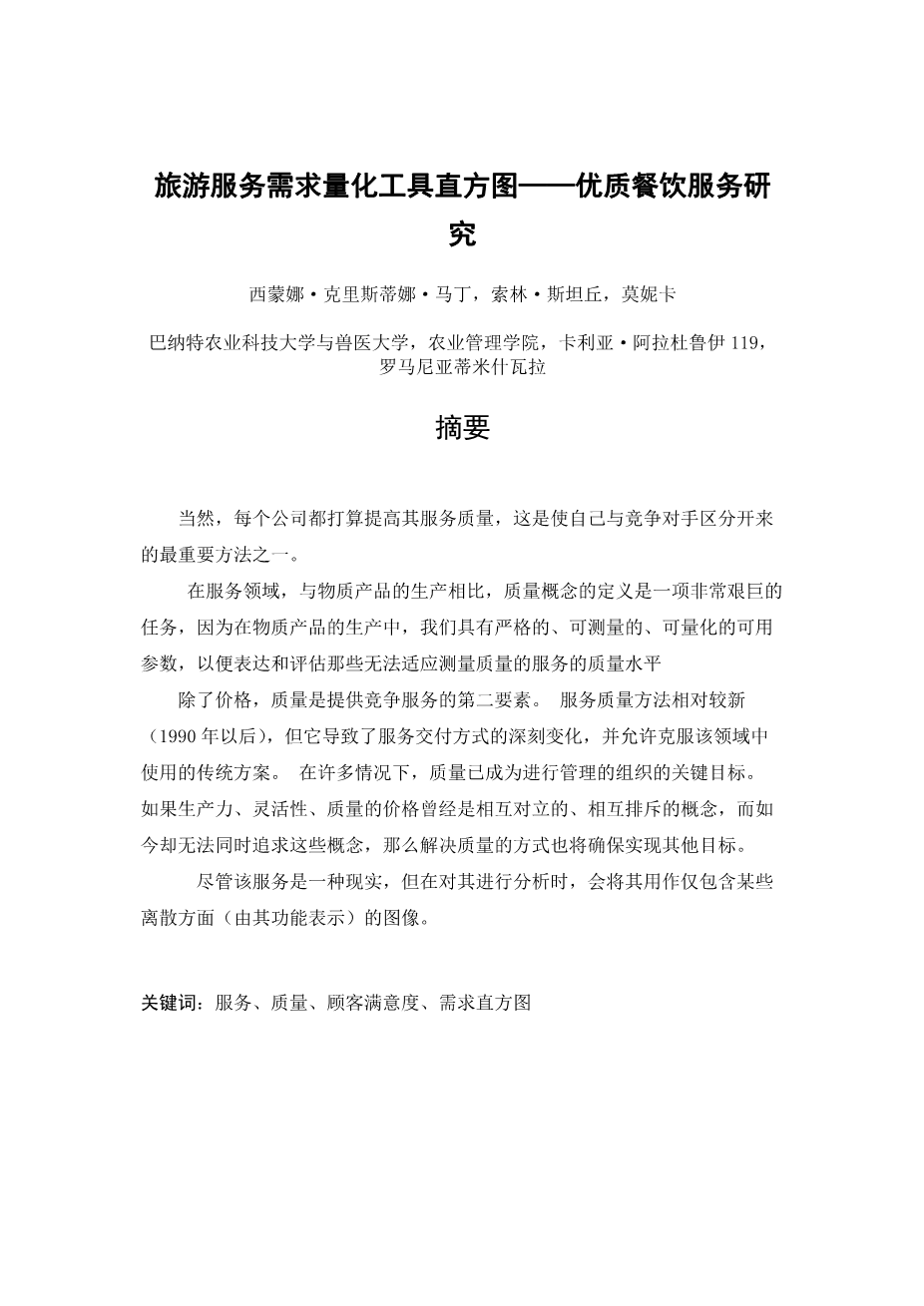The Histogram of Requirements - Quantification Tool for Tourism Services. Study on Quality Catering Services
Simona Cristina Martin, Sorin Stanciu, Monica Ocnean
Banat`s University of Agricultural Sciences and Veterinary Medicine, Faculty of Agricultural Management, Calea Aradului, 119, Timisoara, Romania
Abstract
Naturally, each company intends to increase its services quality, which is one of the most important ways to differentiate themselves from competitors.
In services field, the definition of quality concept is a very difficult task, in comparison with the production of material goods because in the production of material goods we have rigorous available parameters, measurable, quantifiable, in order to express and evaluate the level of quality that not can be adapted to the measure quality services.
Besides the price, the quality is the second element that provides competitive services. Service quality approach is relatively new (after 1990), but it led to profound changes in service delivery way and allowed overcoming traditional schemes used in this area. Quality has become in many cases a critical objective for organizations, which deal, in terms of management. If the price of productivity, flexibility, quality were, once, opposed concepts, which are mutually exclusive, that could not be pursued simultaneously today, the way how addressed quality is, ensures also the achievement of other objectives.
Although the service is a reality, when it is analysed, it is used as an image that includes only certain discrete aspects, represented by its features.
Keywords: services; quality; customer satisfaction; histogram of requirements;
Introduction
Travel services are, in the current structure, the most important group with a share of 63.6%. However, they have seen a decreasing trend in both domestic and international tourism.
It is obvious that tourism services and analysis of the causes of their deterioration is a priority of the utmost importance to make this industry a 'hospitality' in a cost effective resource for the economy. It is necessary to create a 'cult of quality' at all levels, from managers to the last employee in the public catering establishments. This involves cutting out some practices proven inadequate in these units, a reformation of manners a lasting process. But the quality of the
* Corresponding author: Simona Cristina Martin, simi_con@yahoo.it
leaves to be desired, not only because of the conditions which shall be evaluated and certified at the time of their classification but especially by the attitude of the staff.
Materials and methods
To remove the importance of histograms in determining the quality of services in public, feeding units were applied questionnaires in the restaurant 'Students Tavern' from Timișoara.
Results and discussion
In the conception of French authors Tocquer and Langlois [1], the fairest is to define the quality of service as the spread between the customers expectations in terms of quality and service perception after the use of the service. It is the
ratio between the benefits actually obtained when using the service given and expected benefits. One can speak of quality when the service is consistent with expectations or exceed these expectations. If the level of quality offered to meet consumer expectations, he will be pleased and will become a regular client of the providing unit. Otherwise, he is looking for other providers, units will be won from the competition [1].
In evaluating the quality of services by the customers, of particular importance turn out to be the impressions (eg, a market research report, written in neat, surprises in a positive way the research beneficiary in assessing the content) and circumstances in which the services are performed (within 'normal' conditions, tourists seeking accommodation, appreciate features such as price, comfort, cleanliness, etc., but when the tourists are in difficulty, in an isolated area, they will require only a refuge). [2]
Due to competition, quality has become a key element in the countrys effort to maintain the competitiveness of European tourism.
Application of the technology of quality tourist services sector is difficult, because the quality of service provided cannot be separated from the unit that produces it, because otherwise you would not be able to ensure that a service is supplied correctly every day. [3]
In designing a system of quality, the first step is setting the standards product/service depending on the needs of the application. Thats why you need to design systems that can guarantee the fulfilment of quality standards.
For the analysis, evaluation, improvement and quality control, adopted a series of techniques and methodologies that make up an information system.
Currently using seven techniques or procedures that are called quality tools: histograms, charts, cause-effect, Pareto diagrams, diagram of correlation, regression analysis, and control charts. Histograms are used, as a rule, mathematical statistics for plotting the distributions of values, with the objective of determining the quality of a manufacturing process, process capability study, improving quality and eliminate defects, etc.
Histograms are used in two situations:
-When comparing a process with the prescribed specification when it is necessary to analyse the distribution, distribution and then comparing them with the prescribed specification;
-When comparing two or more processes, when issues are followed: the shape, the size distribution range of variation, the volume of goods outside the technical specification, tolerance, position in relation to histogram limits, etc.
We have chosen to promote the process
剩余内容已隐藏,支付完成后下载完整资料


英语译文共 13 页,剩余内容已隐藏,支付完成后下载完整资料
资料编号:[607538],资料为PDF文档或Word文档,PDF文档可免费转换为Word
您可能感兴趣的文章
- 饮用水微生物群:一个全面的时空研究,以监测巴黎供水系统的水质外文翻译资料
- 步进电机控制和摩擦模型对复杂机械系统精确定位的影响外文翻译资料
- 具有温湿度控制的开式阴极PEM燃料电池性能的提升外文翻译资料
- 警报定时系统对驾驶员行为的影响:调查驾驶员信任的差异以及根据警报定时对警报的响应外文翻译资料
- 门禁系统的零知识认证解决方案外文翻译资料
- 车辆废气及室外环境中悬浮微粒中有机磷的含量—-个案研究外文翻译资料
- ZigBee协议对城市风力涡轮机的无线监控: 支持应用软件和传感器模块外文翻译资料
- ZigBee系统在医疗保健中提供位置信息和传感器数据传输的方案外文翻译资料
- 基于PLC的模糊控制器在污水处理系统中的应用外文翻译资料
- 光伏并联最大功率点跟踪系统独立应用程序外文翻译资料



